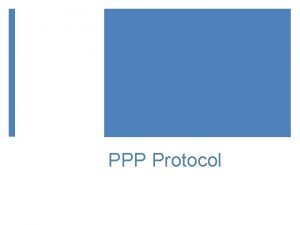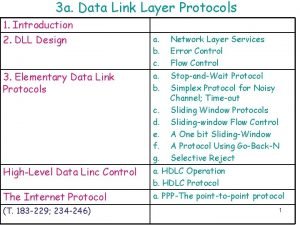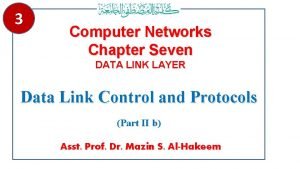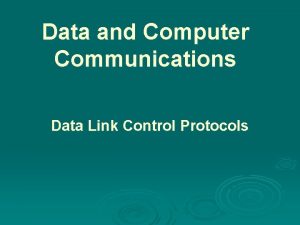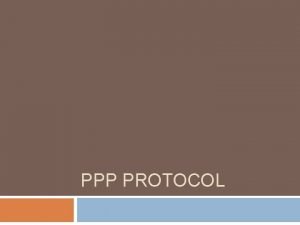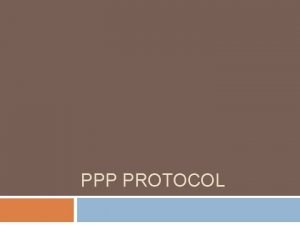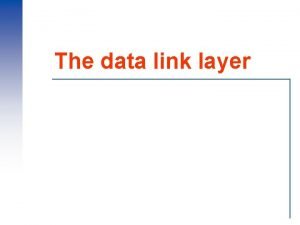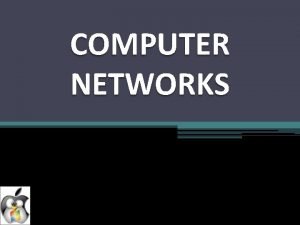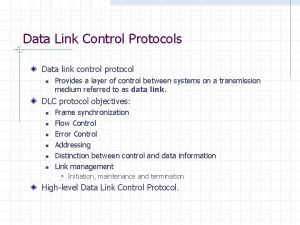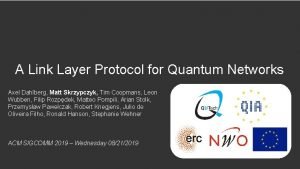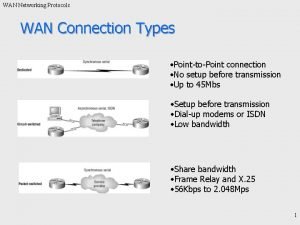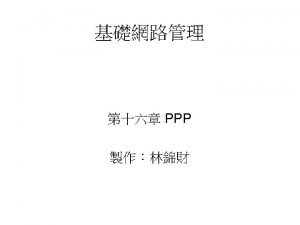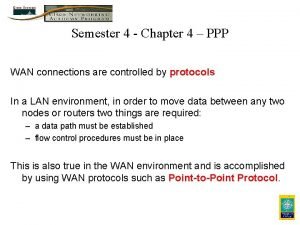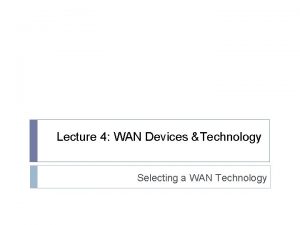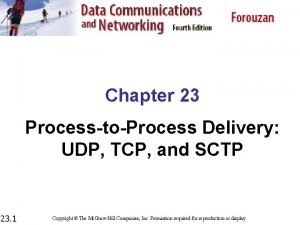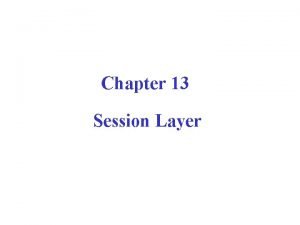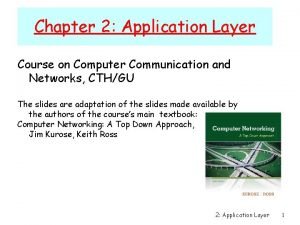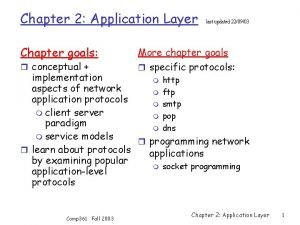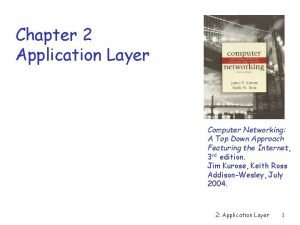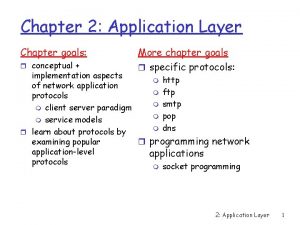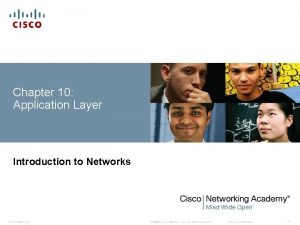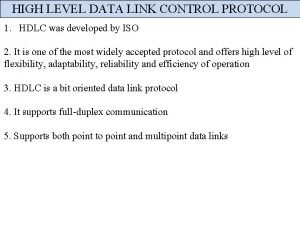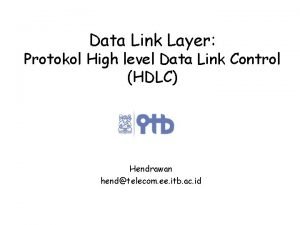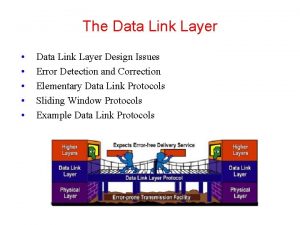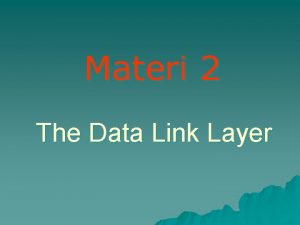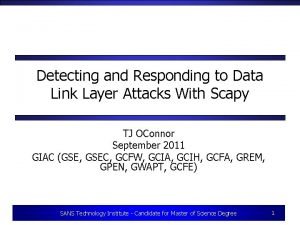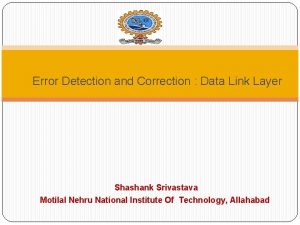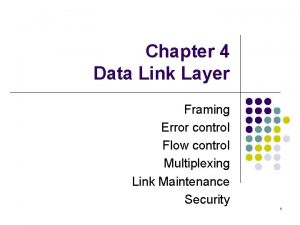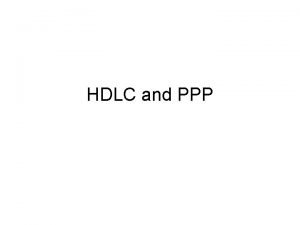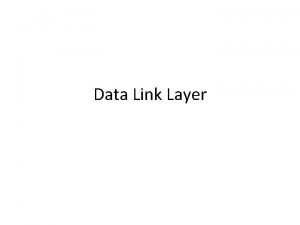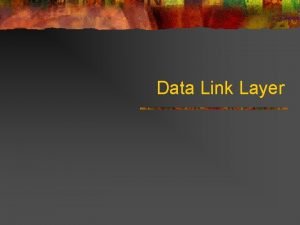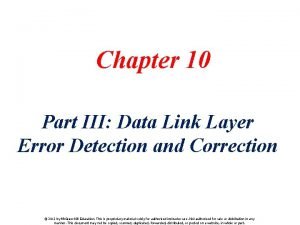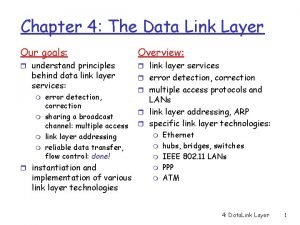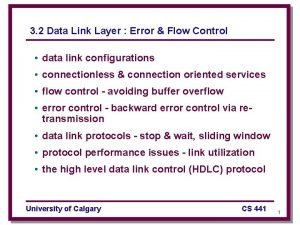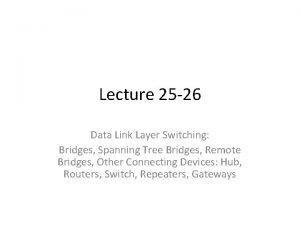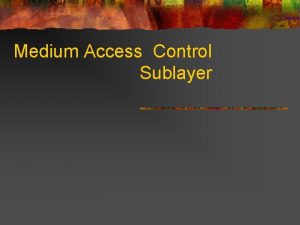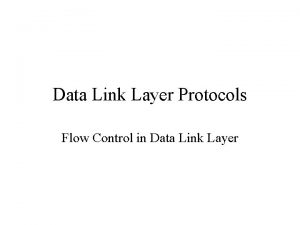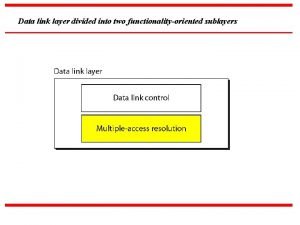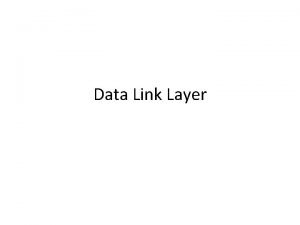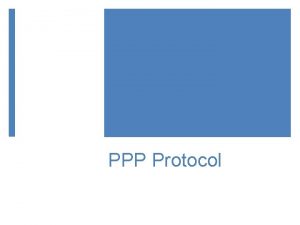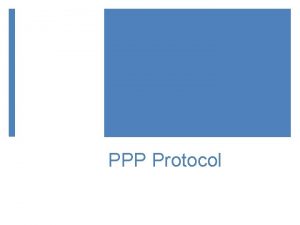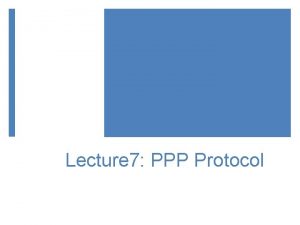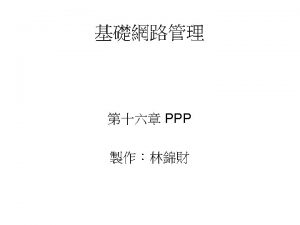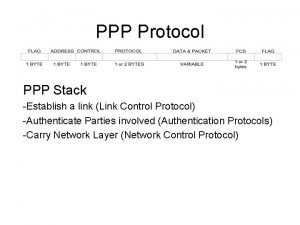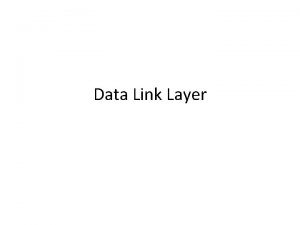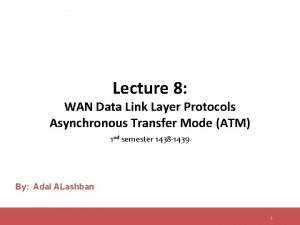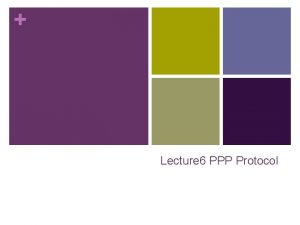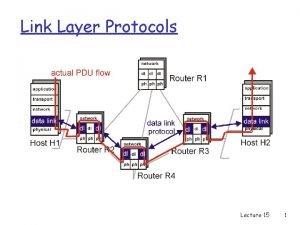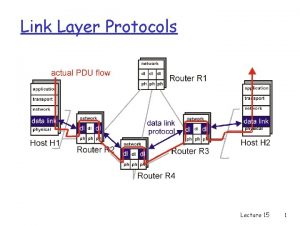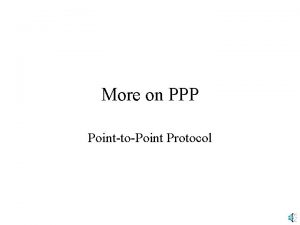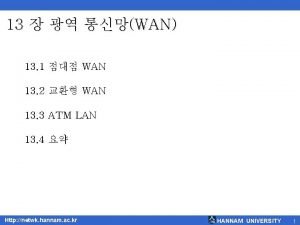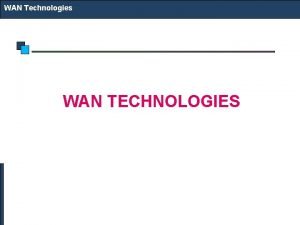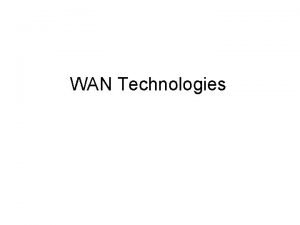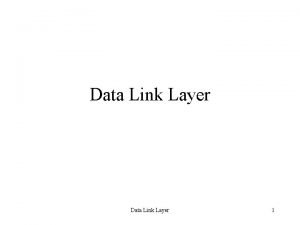PPP Protocol Outline WAN Data Link Layer protocols



















































- Slides: 51

PPP Protocol

Outline ¡WAN Data Link Layer protocols ¡HDLC ¡PPP Protocol ¡LCP ¡NCP ¡PPP Session Establishment Phases ¡Authentication ¡PAP ¡CHAP

WANs ¡As we have learned, all WAN connections consist of two basic elements: ¡ The physical layer devices and transmission media. ¡ Data-link–layer protocols.

WAN Data Link Layer Protocols ¡WANs require Data Link layer protocols to provide communication between two devices across the communication line. ¡Because there are many different ways to connect devices, there are many different data link protocols. ¡Data link protocols may provide any of the following services: ¡ Framing ¡ Session setup and termination ¡ Error detection ¡ Addressing on a multipoint medium

WAN Connection Types WAN Data Link Protocolos ¡Each WAN connection type uses a Data Link layer protocol to encapsulate a packet while it is crossing the WAN link. ¡The choice of encapsulation protocols depends on the WAN technology and the equipment.

HDLC

HDLC ¡High-level Data Link Control (HDLC) is one of the oldest data link layer protocols for the WAN developed by the ISO. ¡HDLC is a bit-oriented protocol for communication over point-topoint and multipoint links. ¡Although HDLC can be used for point-to-multipoint connections, the most common usage of HDLC is for point-to-point serial communications. ¡It supports full-duplex communication.

HDLC ¡The protocol uses the services of a physical layer, and provides either a best effort or reliable communications path between the transmitter and receiver (i. e. with acknowledged data transfer). ¡No authentication can be used with HDLC. ¡Many protocol suites use an HDLC (or HDLC-based) link layer, including X. 25, the IP point-to-point protocol (PPP) and SNA.

HDLC Encapsulation ¡HDLC defines a Layer 2 framing structure that allows for flow control and error control through the use of acknowledgments (just on multipoint). ¡Each frame has the same format, whether it is a data frame or a control frame.

HDLC Encapsulation ¡Flag : ¡ The frame always starts and ends with an 8 -bit Flag field. ¡ The bit pattern is 01111110. ¡ The Flag field initiates and terminates error checking. ¡Transparency ¡ The flag sequence must never occur within the content of a frame. ¡ A technique known as 0 -bit insertion (bit stuffing) is used to prevent random data synthesizing a flag. ¡ This technique make HDLC transparent, since any stream of bits may be present between the open and closing flag of a frame. ¡ The receiving system strips out the inserted bits. ¡When frames are transmitted consecutively, the end flag of the first frame is used as the start flag of the next frame.

Bit stuffing ¡Bit stuffing is the process of adding one extra 0 whenever five consecutive 1 s follow a 0 in the data, so that the receiver does not mistake the pattern 0111110 for a flag.

HDLC Encapsulation ¡Address: ¡ This field is not needed for point-to-point links, but is always included for the sake of uniformity. ¡Control Field: ¡ It defines the three types of frames I, U and S Frame for HDLC. ¡Frame Check Sequence (FCS) ¡ Is usually a cyclic redundancy check (CRC) calculation remainder. ¡ The CRC calculation is redone in the receiver. If the result differs from the value in the original frame, an error is assumed.

HDLC Encapsulation ¡HDLC was not intended to encapsulate multiple Network layer protocols across the same link. ¡ The HDLC header carries no identification of the type of protocol being carried inside the HDLC encapsulation. ¡Because of this, each vendor that uses HDLC has their own way of identifying the Network layer protocol, which means that each vendor’s HDLC is proprietary for their equipment

CHDLC ¡Cisco has developed an extension to the HDLC protocol (Cisco HLDC (CHDLC) )to solve the inability to provide multiprotocol support, . ¡CHDLC frames contain a field for identifying the network protocol being encapsulated.

PPP Protocol

PPP ¡Point-to-Point Protocol (PPP) is the name of a single protocol, whereas the “PPP” can be used to refer to the entire suite of protocols that are related to PPP. ¡The PPP protocol was developed by IETF as a means of transmitting data for more than one network protocol over the same point-to-point serial link in a standard, vendor-independent way. ¡It can carry IP, Novell IPX, Apple. Talk, and DECnet traffic.

PPP ¡PPP also offers many features that HDLC does not including the following: ¡ Authentication through the Password Authentication Protocol (PAP) and the Challenge-Handshake Authentication Protocol (CHAP) ¡ Compression capabilities with Stacker or Predictor ¡ PPP Multilink, the ability to bundle physical channels into a single logical channel. ¡ Support for Error detection and error recovery features ¡ Encapsulation for multiple routed protocols, including IP, Novell IPX, and Apple. Talk

PPP ¡PPP is a layered protocol, starting with a Link Control Protocol (LCP) for link establishment, configuration and testing. Once the LCP is initialized, one or many of several Network Control Protocols (NCPs) can be used to transport traffic for a particular protocol suite.

PPP and PHY Layer ¡PPP operates at the Data Link layer. ¡At the physical layer, PPP can be used across synchronous (e. g. , ISDN, leased lines) and asynchronous (e. g. , modem dialup) data links.

HOW PPP Work ¡The mechanism that PPP uses to carry network traffic is to open a link with a short exchange of packets. ¡Once the link is open, network traffic is carried with very little overhead. Frames are sent as unnumbered information frames, meaning that no data link acknowledgement is required and no retransmissions are carried out. ¡So once the link is established, PPP acts as a straight data pipe for protocols.

PPP Components

PPP Components Three main components: ¡ HDLC: ¡ HDLC protocol for encapsulating datagrams over point-to-point links. ¡ LCP: ¡ To establish, configure, maintain and terminate the data link connection. ¡ NCPs: ¡ Family of NCPs for establishing and configuring different network layer protocols. ¡ Allows simultaneous use of multiple Network layer protocols

Encapsulation ¡PPP defines a Protocol Type field. ¡The protocol type field identifies the type of packet inside the frame, . The following shows a PPP frame.

PPP Data Frame ¡Flag: delimiter (framing) ¡Address: does nothing (only one option) ¡Control: does nothing; in the future possible multiple control fields ¡Protocol: upper layer protocol to which frame delivered (eg, PPPLCP, IPCP, etc) ¡Data: upper layer data being carried ¡FCS: cyclic redundancy check for error detection

Byte Stuffing ¡ One of PPP design requirements is data transparency. ¡ Transparency means carrying any bit pattern in the data field ¡ data field must be allowed to include flag pattern <01111110> ¡ Q: is received <01111110> data or flag? ¡ Sender: adds (“stuffs”) extra < 01111110> byte after each < 01111110> data byte ¡ Receiver: ¡ two 01111110 bytes in a row: discard first byte, continue data reception ¡ single 01111110: flag byte

Byte Stuffing flag byte pattern in data to send flag byte pattern plus stuffed byte in transmitted data

LCP ¡Link establish: The process of bringing up the PPP link before any other protocols can begin transmission. ¡Link configuration: The process of negotiating and setting up the parameters of a link. ¡Link maintenance: The process of managing an opened link. ¡Link termination: The process of closing an existing link when it is no longer needed (or when the underlying physical layer connection closes).

LCP ¡In link configuration, LCP frames are exchanged that enable the two physically-connected devices to negotiate the parameters (configuration options) under which the link will operate. Configure-nak Configure-reject ¡Device 1 sends a configure request frame, containing configuration options. ¡Device 2 responds with a frame confirming that the options are okay, suggesting different options or rejecting the options.

LCP Configuration Options LCP offers PPP different options, including the following: ¡ Maximum-Receive-Unit (MRU): Lets a device specify the maximum size datagram it wants the link to be able to carry. ¡ Authentication-Protocol: the device can indicate the type of authentication protocol it wishes to use (if any). ¡ Compression: Allows the device to specify that it wants to use a compression. This is used to increase throughput of PPP connections ¡ Quality-Protocol: If the device wants to enable quality monitoring on the link, what protocol to use ¡ Other options: Error detection, Magic Number, Multilink

LCP ¡During link maintenance, LCP can use messages to provide feedback and test the link ¡Echo-Request, Echo-Reply, and Discard-Request - These frames can be used for testing the link. ¡Code-Reject and Protocol-Reject - These frame types provide feedback when one device receives an invalid frame due to either an unrecognized LCP code (LCP frame type) or a bad protocol identifier.

LCP ¡The LCP closes the link by exchanging Terminate packets. ¡A termination request indicates that the device sending it needs to close the link. ¡When the link is closing, PPP informs the network layer protocols so that they may take appropriate action.

NCP ¡PPP use the NCP to permit multiple network layer protocols to operate on the same communications link.

NCP ¡For every network layer protocol used, PPP uses a separate NCP. For example, IPv 4 uses the IP Control Protocol (IPCP) and IPv 6 uses IPv 6 Control Protocol (IPv 6 CP).


PPP Session Establishment ¡PPP session establishment progresses through three phases: ¡ link establishment ¡ authentication ¡ network layer protocol phase

PPP Session Establishment (Detail) 1. Link establishment - (LCPs) 2. Authentication - Optional (LCPs) 3. Link quality determination - Optional (LCPs) 4. Network layer protocol configuration (NCPs) 5. Link termination (LCPs)

1 - Link-establishment phase ¡Before any network layer packets can be exchanged, LCP must first open the connection and negotiate the configuration parameters. ¡In this phase each PPP device sends LCP frames to configure the data link. ¡LCP frames contain a configuration option field that allows devices to negotiate the use of options such as the maximum transmission unit (MTU), compression of certain PPP fields, and the link-authentication protocol. ¡If a configuration option is not included in an LCP packet, the default value for that configuration option is assumed. ¡This phase is complete when a configuration acknowledgment frame has been sent and received.


PPP Multilink (MLP) • • In some environments, it may be necessary to bundle multiple serial links to act as single link with aggregated bandwidth. PPP Multilink is common with ISDN.

Compression ¡Point-to-point software compression can be configured on serial interfaces that use PPP encapsulation. ¡Compression is performed in software and might significantly affect system performance because it is software, not hardware compression. ¡Compression can be CPU or memory intensive.

Error Detection ¡Link Quality Monitoring (LQM) is available on all serial interfaces running PPP. ¡LQM will monitor the link quality, and if the quality drops below a configured percentage, the link will be taken down. ¡The percentages are calculated for both the incoming and outgoing directions.

2 - Authentication Phase (Optional) ¡After the link has been established and the authentication protocol decided on, the peer may be authenticated. ¡Authentication, if used, takes place before the network layer protocol phase is entered. ¡As part of this phase, LCP also allows for an optional link-quality determination test. ¡The link is tested to determine whether the link quality is good enough to bring up network layer protocols

Authentication ¡Authentication is a mechanism used to verify the identity of another device. ¡This identity verification is needed to confirm that the other device is legitimate and not some only appearing to be an authentic device in order to cause damage or steal information. ¡PPP defines two authentication protocols: ¡ Password Authentication Protocol (PAP) ¡ Channel Handshake Authentication Protocol (CHAP).

PPP authentication protocols • Both protocols involve exchanges of messages between the two PPP devices, but there are differences in detail.

PAP

Password Authentication Protocol (PAP) ¡PAP provides a simple method for a remote node to establish its identity, using a two-way handshake. ¡The authentication process is one way authentication method and one or both devices can authenticate each other separately. ¡PAP is not a strong authentication protocol. ¡Passwords are sent across the link in clear text and there is no protection from playback or repeated trial-and-error attacks.

CHAP

CHAP ¡CHAP uses a three-way handshake to verify the identity of the remote node. ¡After the PPP link establishment phase is complete, the local router sends a "challenge" message to the remote node. ¡The remote node responds with a value calculated using a one-way hash function, which is typically Message Digest 5 (MD 5). ¡This response is based on the password and challenge message. ¡The local router checks the response against its own calculation of the expected hash value. ¡If the values match, the authentication is acknowledged, otherwise the connection is immediately terminated.

CHAP ¡CHAP provides protection against playback attack through the use of a variable challenge value that is unique and unpredictable. ¡Since the challenge is unique and random, the resulting hash value will also be unique and random.

3 - Network Layer Protocol Phase ¡In this phase the PPP devices send NCP packets to choose and configure one or more network layer protocols, such as IP. ¡Once each of the chosen network layer protocols has been configured, packets from each network layer protocol can be sent over the link. ¡The PPP link remains configured for communications until LCP or NCP frames close the link.

PAP CHAP
 Wan data link protocols
Wan data link protocols Stop-and-wait arq
Stop-and-wait arq Data link layer protocols for noisy and noiseless channels
Data link layer protocols for noisy and noiseless channels Data link control
Data link control Serial
Serial The ppp link control protocol was terminated
The ppp link control protocol was terminated Unrestricted simplex protocol in data link layer
Unrestricted simplex protocol in data link layer Simplex protocol for noisy channel
Simplex protocol for noisy channel Data link layer design issues
Data link layer design issues Elementary data link protocols in computer networks
Elementary data link protocols in computer networks Data link control protocols in computer networks
Data link control protocols in computer networks A link layer protocol for quantum networks
A link layer protocol for quantum networks Network protocols map
Network protocols map Wan technologies overview
Wan technologies overview Wan ppp
Wan ppp Ppp wan
Ppp wan Private wan technologies
Private wan technologies Presentation layer protocols
Presentation layer protocols Tcp and sctp are both layer protocols
Tcp and sctp are both layer protocols Function of session layer
Function of session layer Application layer protocols
Application layer protocols Application layer protocols
Application layer protocols Presentation layer design issues
Presentation layer design issues Application layer protocols
Application layer protocols Application layer protocols
Application layer protocols Application layer protocols
Application layer protocols Application layer protocols
Application layer protocols High level data link control protocol
High level data link control protocol Hdlc osi layer
Hdlc osi layer Data link layer design issues
Data link layer design issues Materi data link layer
Materi data link layer Deauth attack
Deauth attack Gambar data link
Gambar data link Data link layer switching in computer networks
Data link layer switching in computer networks Error detection and correction in data link layer
Error detection and correction in data link layer Data link layer design issues
Data link layer design issues Error control in data link layer
Error control in data link layer Link
Link Data link layer
Data link layer Dll design issues
Dll design issues Error detection methods in data link layer
Error detection methods in data link layer Responsibilities of data link layer
Responsibilities of data link layer Data link layer
Data link layer Dlc in data link layer stands for
Dlc in data link layer stands for Data link layer flow control
Data link layer flow control Two main functions of data link layer are
Two main functions of data link layer are Data link layer switching
Data link layer switching Pengertian physical layer
Pengertian physical layer Channel allocation problem in data link layer
Channel allocation problem in data link layer Unrestricted simplex protocol
Unrestricted simplex protocol Data link layer divided into two sublayers
Data link layer divided into two sublayers Data link layer framing
Data link layer framing
